
TECHNICAL BRIEF NO. 23 2009
PDF version
The Use of CIRRIE's Database of International Rehabilitation Research in Conducting Systematic Reviews
Marcia E. Daumen, MLS, CIRRIE Information Resources Manager
Daniel J. Conley, MLS, CIRRIE Information Specialist
Introduction
The need for evidence-based practice is increasingly called for in disability and rehabilitation. To meet that need, the availability of quality systematic reviews in the field must increase to enable service providers access to all the information necessary to evaluate the effectiveness of procedures and practices in a particular situation.
Systematic reviews collect and examine relevant studies to evaluate and compare them with prescribed and documented criteria. This process needs to include an exhaustive examination of the literature to ensure that the subject has been thoroughly investigated. To conduct a thorough and unbiased systematic review, a variety of bibliographic databases must be searched. Limiting a search to one database is likely to result in overlooking studies relevant to the review. For example, an examination of eight systematic reviews found that a search of MEDLINE alone would have resulted in missing 20% of the studies included in the reviews (Whiting, Westwood, Burke, Sterne, & Glanville, 2008). Earlier research (Savoie, Helmer, Green, & Kazanjian, 2003) on the increased effectiveness of searching specialized databases in addition to MEDLINE found that “an important number of randomized controlled trials (RCTs) were missed by the major database search” (p.168). Stevinson and Lawlor (2004) compared the articles found by searching large, general databases to those located through searches of subject-specific databases, such as PsychInfo or SportDiscus, to evaluate the results for a systematic review in exercise therapy. They found that the benefit from searching additional databases was worth the time involved to ensure adequate coverage of the topic. Additionally, systematic reviews with a global view need to represent all countries. To achieve such global representation, searches must be conducted beyond EMBASE (Excerpta Medica Database) or MEDLINE (Betrán, Say, Gülmezoglu, Allen, & Hampson, 2005).
Background
The Center for International Rehabilitation Research Information and Exchange (CIRRIE) was first funded by the National Institute on Disability, Independent Living, and Rehabilitation Research (NIDILRR) in 1999. Among CIRRIE's charges was the creation of a bibliographic database of citations to articles on research conducted outside of the United States. The database was to be free and Internet-accessible so as to expand U.S. rehabilitation researchers' knowledge of what was being studied elsewhere in the world. Now in its second 5-year funding cycle, CIRRIE's Database of International Rehabilitation Research contains almost 90,000 citations to articles published since 1990. The database includes research conducted in most geographic regions of the world as well as citations to articles originally published in languages other than English. An article presenting an overview and analysis of CIRRIE's database (Fitzpatrick, 2006) called it “an appropriate companion resource to NARIC's [the National Rehabilitation Information Center's] REHABDATA Literature Database” (p.38).
Features
The CIRRIE Database of International Rehabilitation Research includes article citations from all disciplines that relate to disability or rehabilitation, including rehabilitation science, engineering, nursing, medicine, and education among others. To identify citations for inclusion, CIRRIE staff search a number of sources. These include subject-specific databases, which are searched using specifically tailored strategies, as well as well-known databases such as MEDLINE, EMBASE, CINAHL (Cumulative Index to Nursing and Allied Health Literature), PsycINFO, COMPENDEX (the electronic version of Engineering Index), and ERIC (Education Resources Information Center). Regional and smaller subject-specific databases, such as Chinese Educational Resources Information Centre Project (Chinese ERIC) and African Index Medicus, are also searched as identified. In addition, several journals not normally indexed in mainstream databases send CIRRIE their citations and abstracts for inclusion. Such titles include Disability and Employment Journal (Korea) and Deafness and Hearing International (U.K.).
As mentioned, the CIRRIE database contains almost 90,000 citations to articles published since 1990, with new citations being added regularly. Each citation includes the original journal abstract, when permitted, or an abstract written by the CIRRIE staff. All abstracts are in English regardless of the original language of publication. When available, citations provide links to the full text of the article, and those citations indexed in MEDLINE have a link to the PubMed record and abstract as well. Each citation also notes the geographic area, both by country and continent, in which the research was conducted.
Because the CIRRIE database includes only relevant citations concerning disability and rehabilitation, entire journals are not indexed. Nonetheless, more than 5,000 journal titles are represented in the database. To assist in research, an alphabetical list of these journals is available. This list gives the title, contact information, and language of publication for each journal and indicates whether it is indexed in MEDLINE or available through the University at Buffalo's Health Sciences Library. For each journal, the list also provides the five most frequently used subject headings for the articles included in the CIRRIE database.
Locating Collaborators for Systematic Review
The Campbell Collaboration (C2), which produces and distributes systematic reviews on social interventions, includes as one of its key principles the goal of “enabling wide participation in the work of the Collaboration, by reducing barriers to contributing and by encouraging diversity” (The Campbell Collaboration, 2009). In describing how the organization's reviews differ from others, Campbell states that its reviews “are usually international in scope.”
The CIRRIE database can help meet this goal of international inclusion by providing researchers with a way to identify non-U.S. authors. For example, researchers can use the Subject Specialist search page to find authors in the database who have written multiple articles on a particular subject. This information can help identify prolific non-U.S. authors on specific topics of interest. The results of this search provide the selected author's most recent contact and bibliographic information, including the total number of the author's articles in the database and links to the author's five most recent citations.
Searching CIRRIE
A new interface was created for the CIRRIE database in January 2009. This enhancement created a “cleaner” look and increased search flexibility by enabling users more customization of their search queries. With the new interface, the database is searchable by title keyword, subject heading, article author, and journal title. These fields can be searched independently or in tandem by using a pull-down menu. Queries can also be refined through the use of Boolean operators like AND or OR, and limited by the geographic area in which the research was conducted, the original language of publication, and the year in which the article was published.
Figure 1: [Select image to enlarge / return]

Users can search the database by entering information into as many or as few fields as they think necessary. Many users may need only general information, for which a simple keyword search is often sufficient. When more specificity is desired, however, search queries can be refined to find specific results, such as articles describing schizophrenia research conducted in Asia and published within the past 5 years. To refine queries, users enter information in additional search fields, as shown in Figure 1.
In response to a search query, a screen appears showing the total number of article records found in the database. By default, only 10 records are shown at a time, with newer articles listed first. The navigation menu allows users to change these defaults and view up to 50 records per page. Each article's brief record is displayed in the American Psychological Association (APA) format along with a link to the full record.
Selecting an article's full record displays the record view, which provides more information about the article. In addition to the bibliographic information, this view shows the institution of the article's first author; the language in which the article was published; the CIRRIE subject headings under which the article is indexed; the geographic area where the research was conducted (both country and continent, with “international” listed if multiple countries were involved); and the abstract, if one is available. As previously noted, articles indexed in MEDLINE also contain a link to the related MEDLINE abstract. This link enables a user to view the full text of materials available through the National Library of Medicine.
Figure 2: [Select image to enlarge / return]
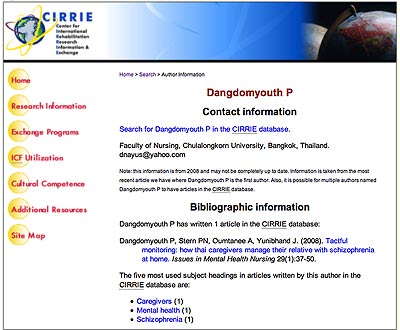
The record view also provides additional access points for searching the CIRRIE database. For example, after using a title-keyword search to arrive at a citation, a user can look at the record view to see the subject headings for that article. Selecting a subject heading from the record view conducts a broad search of the database for that term. Similarly, the record view can be used to conduct a broad search of a geographic area.
From the record view, users can also access detailed author or journal information by selecting the appropriate links. Selecting an author's name displays the individual's most recent contact information as well as the total number of and five most recent articles by that author in the CIRRIE database (see Figure 2). Selecting a journal's name displays the language of publication as well as the five most frequently used subject headings for that journal in the database. This information provides a snapshot of the journal's content, which is particularly useful for non-English journals.
Some people may be more familiar with International Classification of Functioning, Disability and Health (ICF) codes than with CIRRIE subject headings. To assist these people, CIRRIE provides an ICF Crosswalk search page , which enables users to use two-level ICF codes to search the database's subject headings. Entering an ICF code brings up a list of corresponding CIRRIE subject headings (see Figure 3). Users can then select the ones they want to use to search the database. As a further option, users can use ICF classifications to browse the CIRRIE database as well.
For more information on searching the CIRRIE Database of International Rehabilitation Research, please consult the Quick Guide to Searching on pages 6 and 7 of this article or the online guide.
Figure 3: [Select image to enlarge / return]
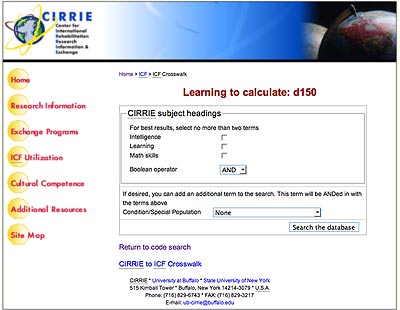
Use of CIRRIE in Systematic Reviews
A variety of systematic reviews have incorporated the CIRRIE database. Examples of these reviews include the following:
Barclay-Goddard, R. E., Stevenson, T. J., Poluha, W., Moffatt, M., & Taback, S. P. (2004). Force platform feedback for standing balance training after stroke. Cochrane Collaboration 4. Retrieved April 7, 2009, from http://mrw.interscience.wiley.com/cochrane/clsysrev/articles/CD004129/frame.html
Beaupre, L. A., Jones, C. A., Saunders, L. D., Johnston, D. W. C., Buckingham, J., & Majumdar, S. R. (2005). Best practices for elderly hip fracture patients: A systematic overview of the evidence. Journal of General Internal Medicine 20(11), 1019–1025.
Chapell, R., Reston, J., Snyder, D., Treadwell, J., Tregear, S., & Turkelson, C. (2003). Management of treatment-resistant epilepsy (Evidence Report/Technology Assessment No. 77. AHRQ Publication No. 03-E028). Rockville, MD: Agency for Healthcare Research and Quality. Retrieved April 7, 2009, from http://www.ahrq.gov/clinic/epcsums/epilsum.htm
Erren-Wolters, C. V., van Dijk, H., de Kort, A. C., Ijzerman, M. J., & Jannink, M. J. (2007). Virtual reality for mobility devices: Training applications and clinical results: A review. International Journal of Rehabilitation Research 30(2), 91–96.
French, B., Leathley, M., Sutton, C., McAdam, J., Thomas, L., Forster, A., et al. (2008). A systematic review of repetitive functional task practice with modeling of resource use, costs and effectiveness. Health Technology Assessment 12(30), 1–117.
Kloosterman, M. G., Snoek, G. J., Jannink, M. J. (2008). Systematic review of the effects of exercise therapy on the upper extremity of patients with spinal-cord injury. Spinal Cord 47(3), 196–203. Advance online publication. Retrieved April 7, 2009. doi:10.1038/sc.2008.113
Prange, G. B., Jannink, M. J., Groothuis-Oudshoorn, C. G., Hermens, H. J., & Ijzerman, M. J. (2006). Systematic review of the effect of robot-aided therapy on recovery of the hemiparetic arm after stroke. Journal of Rehabilitation Research and Development 43(2), 171–184.
Waddell, G., & Burton, A. K. (2004). Concepts of rehabilitation for the management of common health problems. London, England: The Stationery Office.
[Select image to enlarge / return]

General Guidelines
- The search fields are not case sensitive: polio and Polio are the same.
- Multi-word phrases must be encased within quotation marks. Ex: “Daily living.”
- The menu to the right of the search box allows you to choose which field you would like to search: title keyword, subject heading, author or journal.
- To search by multiple fields, select “Add another term.” A new search box will appear, allowing you to repeat the above process up to four more times. These additional fields can be joined to previous searches by ANDing or ORing them together.
- Search for non-English words by removing all accents and diacritical marks: senor instead of señor
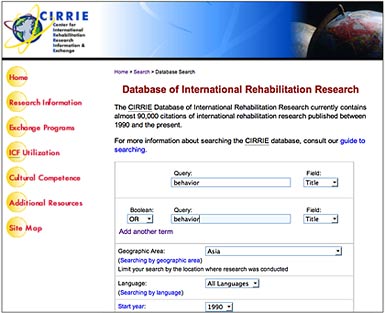
Title/Keyword Search
- Use quotation marks for phrases: Daily living will search Daily AND living. While it will match all articles that “Daily living” will, it may also give false positives.
- The title search also functions as a keyword search. It will not, however, search the abstracts of the articles.
- Remember that the CIRRIE database is international. To account for differences in American and British spelling, search behavior or behaviour.
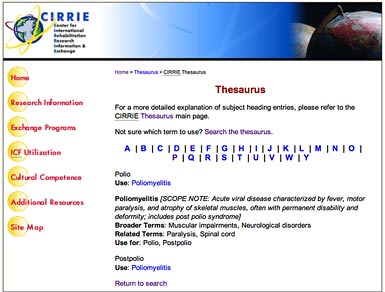
Subject Heading Search
- CIRRIE uses a controlled vocabulary for its subject searches. Check the Thesaurus for the correct term.
Ex: Searching polio will return no results as it is not an approved subject heading. Use poliomyelitis. - Only enter one subject heading per search box. For searching with multiple terms, select “Add another term” and an additional search field will appear.
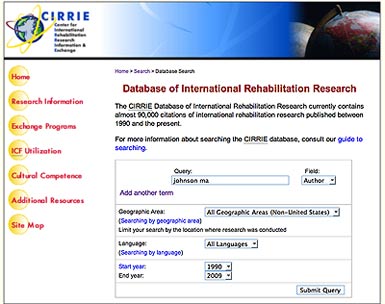
Author Search
- To search by author, enter all or the start of an author's last name. If including initials, include no punctuation or spaces.
- johnson ma
- johnson
- johns - Select author from pull down field menu.
- The database searches the first four authors of an article; if an author was listed fifth or later, they will not be included in the results.
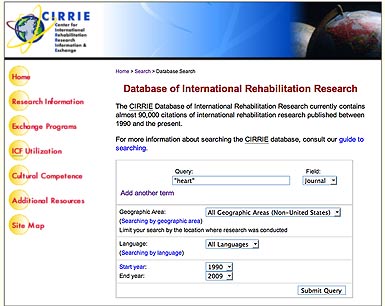
Journal Search
- To search by journal, enter words or phrases from the journal title.
- Select Journal from pull down field menu.
- To search for an exact journal title, place within quotes, even if it is one word.
Ex: Searching heart will match Heart Disease and Heart and Lung, while the “heart” will only provide results from the journal with the exact title Heart.
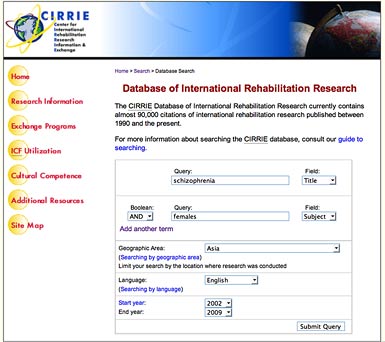
Search Limits
Use one or more of the following fields:
- Geographic area
- Publication year
- Language
To request additional help searching please contact:
Marcia E. Daumen, CIRRIE Resources Manager
State University of New York at Buffalo Health Sciences Library
Buffalo, New York 14214-3079 U.S.A.
Phone: (716) 829-3900 ext.146
FAX: (716) 829-2211
E-mail: daumen@buffalo.edu
References
Betrán, A. P., Say, L., Gülmezoglu, A. M., Allen, T., & Hampson, L. (2005). Effectiveness of different databases in identifying studies for systematic reviews: Experience from the WHO systematic review of maternal morbidity and mortality. BMC Medical Research Methodology 5(1), 6.
The Campbell Collaboration (2009). C2 Home Page. Retrieved January 20, 2009, from https://www.campbellcollaboration.org
Fitzpatrick, R. B. (2006). CIRRIE: An international rehabilitation resource. Medical Reference Services Quarterly 25(4), 37–46.
Savoie, I., Helmer, D., Green, C. J., & Kazanjian, A. (2003). Beyond Medline: Reducing bias through extended systematic review search. International Journal of Technology Assessment in Health Care 19(1), 168–178.
Stevinson, C., & Lawlor, D. A. (2004). Searching multiple databases for systematic reviews: Added value or diminishing returns? Complementary Therapies in Medicine 12(4), 228–232.
Whiting, P., Westwood, M., Burke, M., Sterne, J., & Glanville, J. (2008). Systematic reviews of test accuracy should search a range of databases to identify primary studies. Journal of Clinical Epidemiology 61(4), 357–364.